#Learn to Build Android Apps
Explore tagged Tumblr posts
Text
Learn Android App Development from Scratch: Hands-on Projects with Code with TLS
If you're looking to kickstart your career in mobile app development, learning Android App Development is one of the most rewarding paths. With millions of Android users worldwide, the demand for skilled Android developers is higher than ever. At Code with TLS, we provide a comprehensive, hands-on approach to help you learn Android App Development from scratch, giving you the tools and skills you need to build your own mobile applications.
Why Choose Code with TLS for Android App Development?
At Code with TLS, we believe that the best way to learn Android development is through practical experience. Our Android App Development course is designed with beginners in mind, taking you from the basics all the way to building fully functional apps. By focusing on hands-on projects, you will not only understand the theory but also gain practical experience in the field, ensuring that you’re ready to take on real-world challenges.
What Will You Learn?
Our Android development course covers everything you need to know to create Android applications, including:
Java and Kotlin Programming Languages: We teach you the essential programming languages used for Android development, including Java and Kotlin. These languages are the backbone of Android apps and are crucial for building efficient and powerful applications.
UI/UX Design: Learn how to design intuitive and attractive user interfaces that engage users, an essential skill for any app developer.
Android Studio: Master Android Studio, the official Integrated Development Environment (IDE) for Android development, to create, test, and debug your apps.
Building Real-World Apps: Throughout the course, you will create hands-on projects, such as building a weather app, a task manager, or even a social media app, ensuring you have practical knowledge and a portfolio to showcase.
Why Hands-on Projects Matter
Theory is important, but hands-on projects are what truly prepare you for a career in Android app development. When you work on real projects, you learn how to solve actual problems that developers face in the industry. By the end of the course, you'll have a working portfolio of apps that you can share with potential employers or clients.
Get Started with Code with TLS
At Code with TLS, we are not just a tech course provider; we are your partner in building a successful Android development career. Our expert mentors, interactive learning modules, and community support will ensure you stay on track and achieve your goals. Whether you’re aiming to build your own apps or land a job in Android development, our course will give you the skills and confidence to succeed.
Enroll today and start learning Android App Development from scratch with Code with TLS—the best choice for aspiring Android developers.
#Android App Development#Learn Android Development#Android Development Course#Tech Course Provider#Code with TLS#Learn to Build Android Apps#Android Programming for Beginners#Hands-on Android Projects#Java and Kotlin for Android#Mobile App Development Training#Build Your First Android App#Best Android Development Course#Android Studio Tutorial#Android Developer Bootcamp#Learn Kotlin for Android#Android App Development Course 2025
0 notes
Text
Start Your App Development Journey Today with Robotic Sysinfo: The Best App Development Company in Karnal!

I want to be an app developer, but I feel like I'm starting from scratch. Trust me, you're not alone. It feels like the tech world is some exclusive club, and you're standing outside looking in. But here's the thing: becoming an app developer, even with no experience, is 100% within your reach. It's all about taking that first step and staying motivated, no matter what. Our team has 5+ years of experience in app development solutions. So, let's get started and talk about how you can make this dream a reality—without any experience in your pocket yet.
Problem: The Struggle to Start
We've all been there. You want to break into a new field, but the amount of knowledge and skills you need feels impossible to conquer. You might be wondering: Can I even do this? Where do I start? What are all the things that I need to know to start building an application from scratch? It's pretty easy to get the feeling of lagging behind, especially when you view some of those super cool applications that you have installed on your mobile or the developers coding in lightning speed. It feels as though everyone has it all covered, and here you are stuck.
Solution: Your Pathway to Becoming an App Developer
Let's break this down into manageable steps. This journey may take a while, but every step forward will help you get closer to your goal.
Learn the Basics of Programming Languages
Code knowledge is what one needs in order to make an app. Don't be too worried though; you are not supposed to be a wizard overnight. Start learning the basics of some programming language, which will be good for beginners. Swift is for iOS apps while Kotlin is suitable for Android. JavaScript is ideal for something universally available. Go for one at a time. Free tutorials abound on the internet, while platforms like Codecademy or Udemy present structured courses so you can work your way toward getting the basics down.
Now get out there and start building something
Now, fun part: Create! Yes, you will not build the next Instagram tomorrow; that is okay, too. Try something simple for now, say a to-do list app or a weather app. You aren't going for a masterpiece, but for trying, experimenting, and learning. Don't sweat it if everything doesn't seem to work exactly as expected right off; that is how it is in the process of learning.
Participate in Developer Community
Sometimes, building an app on your own can feel lonely, but guess what? You don't have to do this by yourself. There are entire communities of developers out there—many of them started from scratch just like you. Forums like Stack Overflow, Reddit's r/learnprogramming, or local coding meetups are places where you can ask questions, get advice, and make connections. These communities are full of people who want to see you succeed, and they'll help you get through the tough patches.
Create a Portfolio of Your Work
Once you’ve started building apps, showcase them! Create a portfolio that highlights your work, even if it’s just a few small projects. A portfolio is essential to landing your first job or freelance gig. Make it public on platforms like GitHub or build your own website. Show the world that you’re serious about your new career, and let potential employers or clients see your growth.
Take Online Courses to Take It to the Next Level
If you want to level up your skills, consider enrolling in a structured online course. Websites like Udacity, Coursera, or freeCodeCamp offer great resources for both beginners and intermediate learners. Getting a certification can also boost your credibility and show potential employers that you've got the skills to back up your passion.
Look for Freelance Opportunities or Internships
With that said, as you build some small confidence, find opportunities where you can implement this knowledge into the real world. Start applying for internships or volunteer work. Don't be afraid to take small gigs; places like Upwork and Fiverr offer many smaller projects, just right for those starting out. Every single one of them teaches you something and gets you a little bit closer to what you want to be.
Why You Should Wait: The Tech Industry is Booming
Here's the exciting part—the app development industry is growing fast. According to Statista, the mobile app market generated over $407 billion in 2023. This means there are endless opportunities for developers. Whether you're building the next great social media app, a life-saving health app, or an awesome game, the demand is huge. And it's only going to keep growing.
One company that started with zero experience and grew into something amazing is Robotic Sysinfo, an app development company in Karnal, India. Now, our team has 5+ years of experience in this field. They started small, and through dedication, they’ve become a leading player in the app development world. Their story is proof that with persistence, even those who start with no experience can build something great.
Read More:
Conclusion: You’ve Got This!
It's time to stop wondering whether you can. Yes, you should try! The process of becoming an app developer isn't an overnight thing; however, it can happen if you start small, continue pushing, and embrace the journey. You would surely stumble, but with every line of code written, you are getting stronger and stronger before you even realize how far you have come.
Remember: the world needs more developers, and this is your chance to be in this exciting world. Whether you aspire to create something big or are just learning because you love the idea, today is the best time to fit into it. Your future as an app developer begins today. So, let's get started on your journey with a real app development company like Robotic Sysinfo!
#app development#app developer#no experience#beginner developer#Robotic Sysinfo#Karnal#mobile app development#learn to code#start coding#tech career#app development guide#coding journey#software development#Android development#iOS development#programming for beginners#learn programming#build apps#developer community#tech industry#freelance app developer#app development company
0 notes
Text
MetNet-3: A state-of-the-art neural weather model available in Google products
New Post has been published on https://thedigitalinsider.com/metnet-3-a-state-of-the-art-neural-weather-model-available-in-google-products/
MetNet-3: A state-of-the-art neural weather model available in Google products
Posted by Samier Merchant, Google Research, and Nal Kalchbrenner, Google DeepMind
Forecasting weather variables such as precipitation, temperature, and wind is key to numerous aspects of society, from daily planning and transportation to energy production. As we continue to see more extreme weather events such as floods, droughts, and heat waves, accurate forecasts can be essential to preparing for and mitigating their effects. The first 24 hours into the future are especially important as they are both highly predictable and actionable, which can help people make informed decisions in a timely manner and stay safe.
Today we present a new weather model called MetNet-3, developed by Google Research and Google DeepMind. Building on the earlier MetNet and MetNet-2 models, MetNet-3 provides high resolution predictions up to 24 hours ahead for a larger set of core variables, including precipitation, surface temperature, wind speed and direction, and dew point. MetNet-3 creates a temporally smooth and highly granular forecast, with lead time intervals of 2 minutes and spatial resolutions of 1 to 4 kilometers. MetNet-3 achieves strong performance compared to traditional methods, outperforming the best single- and multi-member physics-based numerical weather prediction (NWP) models — such as High-Resolution Rapid Refresh (HRRR) and ensemble forecast suite (ENS) — for multiple regions up to 24 hours ahead.
Finally, we’ve integrated MetNet-3’s capabilities across various Google products and technologies where weather is relevant. Currently available in the contiguous United States and parts of Europe with a focus on 12 hour precipitation forecasts, MetNet-3 is helping bring accurate and reliable weather information to people in multiple countries and languages.
MetNet-3 precipitation output summarized into actionable forecasts in Google Search on mobile.
Densification of sparse observations
Many recent machine learning weather models use the atmospheric state generated by traditional methods (e.g., data assimilation from NWPs) as the primary starting point to build forecasts. In contrast, a defining feature of the MetNet models has been to use direct observations of the atmosphere for training and evaluation. The advantage of direct observations is that they often have higher fidelity and resolution. However, direct observations come from a large variety of sensors at different altitudes, including weather stations at the surface level and satellites in orbit, and can be of varying degrees of sparsity. For example, precipitation estimates derived from radar such as NOAA’s Multi-Radar/Multi-Sensor System (MRMS) are relatively dense images, whereas weather stations located on the ground that provide measurements for variables such as temperature and wind are mere points spread over a region.
In addition to the data sources used in previous MetNet models, MetNet-3 includes point measurements from weather stations as both inputs and targets with the goal of making a forecast at all locations. To this end, MetNet-3’s key innovation is a technique called densification, which merges the traditional two-step process of data assimilation and simulation found in physics-based models into a single pass through the neural network. The main components of densification are illustrated below. Although the densification technique applies to a specific stream of data individually, the resulting densified forecast benefits from all the other input streams that go into MetNet-3, including topographical, satellite, radar, and NWP analysis features. No NWP forecasts are included in MetNet-3’s default inputs.
A) During training, a fraction of the weather stations are masked out from the input while kept in the target. B) To evaluate generalization to untrained locations, a set of weather stations represented by squares is never used for training and is only used for evaluation. C) Data from these held out weather stations with sparse coverage is included during evaluation to determine prediction quality in these areas. D) The final forecasts use the full set of training weather stations as input and produce fully dense forecasts aided by spatial parameter sharing.
High resolution in space and time
A central advantage of using direct observations is their high spatial and temporal resolution. For example, weather stations and ground radar stations provide measurements every few minutes at specific points and at 1 km resolutions, respectively; this is in stark contrast with the assimilation state from the state-of-the-art model ENS, which is generated every 6 hours at a resolution of 9 km with hour-by-hour forecasts. To handle such a high resolution, MetNet-3 preserves another of the defining features of this series of models, lead time conditioning. The lead time of the forecast in minutes is directly given as input to the neural network. This allows MetNet-3 to efficiently model the high temporal frequency of the observations for intervals as brief as 2 minutes. Densification combined with lead time conditioning and high resolution direct observations produces a fully dense 24 hour forecast with a temporal resolution of 2 minutes, while learning from just 1,000 points from the One Minute Observation (OMO) network of weather stations spread across the United States.
MetNet-3 predicts a marginal multinomial probability distribution for each output variable and each location that provides rich information beyond just the mean. This allows us to compare the probabilistic outputs of MetNet-3 with the outputs of advanced probabilistic ensemble NWP models, including the ensemble forecast ENS from the European Centre for Medium-Range Weather Forecasts and the High Resolution Ensemble Forecast (HREF) from the National Oceanic and Atmospheric Administration of the US. Due to the probabilistic nature of the outputs of both models, we are able to compute scores such as the Continuous Ranked Probability Score (CRPS). The following graphics highlight densification results and illustrate that MetNet’s forecasts are not only of much higher resolution, but are also more accurate when evaluated at the overlapping lead times.
Top: MetNet-3’s forecast of wind speed for each 2 minutes over the future 24 hours with a spatial resolution of 4km. Bottom: ENS’s hourly forecast with a spatial resolution of 18 km. The two distinct regimes in spatial structure are primarily driven by the presence of the Colorado mountain ranges. Darker corresponds to higher wind speed. More samples available here: 1, 2, 3, 4.
Performance comparison between MetNet-3 and NWP baseline for wind speed based on CRPS (lower is better). In the hyperlocal setting, values of the test weather stations are given as input to the network during evaluation; the results improve further especially in the early lead times.
In contrast to weather station variables, precipitation estimates are more dense as they come from ground radar. MetNet-3’s modeling of precipitation is similar to that of MetNet-1 and 2, but extends the high resolution precipitation forecasts with a 1km spatial granularity to the same 24 hours of lead time as the other variables, as shown in the animation below. MetNet-3’s performance on precipitation achieves a better CRPS value than ENS’s throughout the 24 hour range.
Case study for Thu Jan 17 2019 00:00 UTC showing the probability of instantaneous precipitation rate being above 1 mm/h on CONUS. Darker corresponds to a higher probability value. The maps also show the prediction threshold when optimized towards Critical Success Index CSI (dark blue contours). This specific case study shows the formation of a new large precipitation pattern in the central US; it is not just forecasting of existing patterns. Top: ENS’s hourly forecast. Center: Ground truth, source NOAA’s MRMS. Bottom: Probability map as predicted by MetNet-3. Native resolution available here.
Performance comparison between MetNet-3 and NWP baseline for instantaneous precipitation rate on CRPS (lower is better).
Delivering realtime ML forecasts
Training and evaluating a weather forecasting model like MetNet-3 on historical data is only a part of the process of delivering ML-powered forecasts to users. There are many considerations when developing a real-time ML system for weather forecasting, such as ingesting real-time input data from multiple distinct sources, running inference, implementing real-time validation of outputs, building insights from the rich output of the model that lead to an intuitive user experience, and serving the results at Google scale — all on a continuous cycle, refreshed every few minutes.
We developed such a real-time system that is capable of producing a precipitation forecast every few minutes for the entire contiguous United States and for 27 countries in Europe for a lead time of up to 12 hours.
Illustration of the process of generating precipitation forecasts using MetNet-3.
The system’s uniqueness stems from its use of near-continuous inference, which allows the model to constantly create full forecasts based on incoming data streams. This mode of inference is different from traditional inference systems, and is necessary due to the distinct characteristics of the incoming data. The model takes in various data sources as input, such as radar, satellite, and numerical weather prediction assimilations. Each of these inputs has a different refresh frequency and spatial and temporal resolution. Some data sources, such as weather observations and radar, have characteristics similar to a continuous stream of data, while others, such as NWP assimilations, are similar to batches of data. The system is able to align all of these data sources spatially and temporally, allowing the model to create an updated understanding of the next 12 hours of precipitation at a very high cadence.
With the above process, the model is able to predict arbitrary discrete probability distributions. We developed novel techniques to transform this dense output space into user-friendly information that enables rich experiences throughout Google products and technologies.
Weather features in Google products
People around the world rely on Google every day to provide helpful, timely, and accurate information about the weather. This information is used for a variety of purposes, such as planning outdoor activities, packing for trips, and staying safe during severe weather events.
The state-of-the-art accuracy, high temporal and spatial resolution, and probabilistic nature of MetNet-3 makes it possible to create unique hyperlocal weather insights. For the contiguous United States and Europe, MetNet-3 is operational and produces real-time 12 hour precipitation forecasts that are now served across Google products and technologies where weather is relevant, such as Search. The rich output from the model is synthesized into actionable information and instantly served to millions of users.
For example, a user who searches for weather information for a precise location from their mobile device will receive highly localized precipitation forecast data, including timeline graphs with granular minute breakdowns depending on the product.
MetNet-3 precipitation output in weather on the Google app on Android (left) and mobile web Search (right).
Conclusion
MetNet-3 is a new deep learning model for weather forecasting that outperforms state-of-the-art physics-based models for 24-hour forecasts of a core set of weather variables. It has the potential to create new possibilities for weather forecasting and to improve the safety and efficiency of many activities, such as transportation, agriculture, and energy production. MetNet-3 is operational and its forecasts are served across several Google products where weather is relevant.
Acknowledgements
Many people were involved in the development of this effort. We would like to especially thank those from Google DeepMind (Di Li, Jeremiah Harmsen, Lasse Espeholt, Marcin Andrychowicz, Zack Ontiveros), Google Research (Aaron Bell, Akib Uddin, Alex Merose, Carla Bromberg, Fred Zyda, Isalo Montacute, Jared Sisk, Jason Hickey, Luke Barrington, Mark Young, Maya Tohidi, Natalie Williams, Pramod Gupta, Shreya Agrawal, Thomas Turnbull, Tom Small, Tyler Russell), and Google Search (Agustin Pesciallo, Bill Myers, Danny Cheresnick, Lior Cohen, Maca Piombi, Maia Diamant, Max Kamenetsky, Maya Ekron, Mor Schlesinger, Neta Gefen-Doron, Nofar Peled Levi, Ofer Lehr, Or Hillel, Rotem Wertman, Vinay Ruelius Shah, Yechie Labai).
#000#Administration#agriculture#Analysis#android#animation#app#Art#atmosphere#Blue#Building#Case Study#Dark#data#Deep Learning#development#direction#effects#efficiency#energy#energy production#Europe#Events#extreme weather#Features#floods#forecast#Fraction#Full#Future
0 notes
Text
150 things to do when you're bored 🧸🍰🍓

make a journal and write down about your dreams.
try baking a cake.
draw sanrio characters.
learn choreo of the song 'war of hormones' by bts.
stream bts songs or your favorite band's songs.
clean your room.
play any cute mobile games like Purrfect Tale, Resonance of Ocean, Resortopia, Sumikkogurashi Farm, Rhythm Hive, HelloKittyWorld2 Sanrio Kawaii and more. (these are available on android)
plant some trees.
watch any ghibli studio movie.
declutter your phone.
watch some aesthetic japan vlogs.
read a book.
do some skincare.
make a playlist on spotify about the songs you would like to play if you owned a cute café.
write a book about your dream world.
do pilates.
try coquette aesthetic makeup.
start crocheting.
go for a bicycle ride.
have picnic with friends or alone.
watch youtube videos.
go stargazing.
try skateboarding.
go for a walk and observe the beautiful nature and then journal about it.
try cooking with your partner or friends
make a youtube channel.
start a side hustle.
start blogging.
read your favorite blogs.
listen a podcast.
write a song about your favorite person.
make music on bandlab.
write down goals you want to achieve.
learn new language.
re-organise your closet.
take a day off from social media.
take a nap.
organise your pinterest boards.
write a poem.
write a letter to yourself.
make a cute diy necklace.
invent a cute game to play with your friends.
learn to count in another language.
look through a cookbook and try something new.
water the plants.
pray.
try meditating for 5 minutes.
read my blogs :) <3
draw cute doodles.
make cute things out of air dry clay.
create cute diy stickers.
bake cookies in cute fun shapes.
build a blanket fort and read a book inside while eating snacks.
create a scrapbook of favorite memories.
paint rocks with colorful cute designs.
make cute bracelets for your bestfriend.
write a cute story about fairies.
make homemade popsicles with fruit juice.
watch the sunset or sunrise and take a moment to appreciate the beauty of nature.
go for a nature walk and collect interesting leaves or stones.
have a movie marathon with your favorite films.
have a fashion show with clothes from your closet.
design and decorate your own phone case.
create a memory jar filled with notes of happy moments.
design and paint your own ceramic plant pots.
learn about law of attraction.
do research about the history of something of your interest like 'how it was invented?', 'who started it?'.
create your own font.
play an old online game.
try a coloring app.
work on your wish list.
paint your nails.
take a bubble bath.
start a garden.
make your own short movie with your phone.
complete a puzzle.
write about the most beautiful dream you have ever saw.
organize your house.
make a smoothie.
put an appreciation message on a balloon and let it go.
complete a challenge like 30 day self care challenge, 30 day writing challenge and more.
visit a local art gallery.
watch a lecture or TED talk.
read a self-help book.
read a book on astronomy.
click aesthetic pictures of nature.
make your phone look aesthetic.
give your bedroom a makeover on ghibli studio aesthetic.
create a toothpick tower.
practice writing from your non dominate hand.
write about what a day in your dream life looks like.
take out your pet for a walk.
make something wearable for your pet.
learn about how to beat procrastination.
make a little plushie out of your old socks.
learn a new skill.
make a cute website in carrd.co.
write down 10 things you're grateful for.
sit by a river.
visit a local bakery.
walk around a lake.
scroll on pinterest about nature.
walk in the rain.
watch classic films.
watch fashion shows on youtube.
get a haircut.
drink water, take care of yourself <3
read some beauty tips.
watch ballet videos.
write a quote on moon.
say yes to everything for a day.
read some interesting articles.
watch your comfort movie.
write a fiction story.
make your own calendar.
have an indoor picnic with your partner.
write a list of things you will do with your bestie.
crochet something for your loved one or yourself.
learn graphic designing.
write 10 beautiful things about yourself.
make paper stars.
explore interesting websites.
explore your neighborhood.
make a yummy snack.
make hwachae.
try origami.
write a list of your favorite songs explaining why you love it.
watch run bts.
read some manga.
make strawberry cake.
watch conan gray's old vlogs <3
watch onegai my melody :D
design and launch a cute social media challenge to spread positivity and creativity online.
host a themed dinner party with your friends where everyone dresses up and brings a dish from a different culture.
have a spa day at home complete with homemade facemasks, bath bombs, and soothing music.
design a pretty jewellery.
draw your dream house.
try out guided meditation videos (you will find in youtube).
learn about a new culture.
make homemade jam.
do a random act of kindness.
research and plan a future trip.
try a new type of workout video.
research and practice self-defense techniques.
try a new type of creative writing (screenwriting, playwriting, etc.).
try a new type of DIY beauty product (lip balm, body scrub, etc.).
watch a documentary.
learn about constellations and stargaze.
practice calligraphy.
do a riddle.
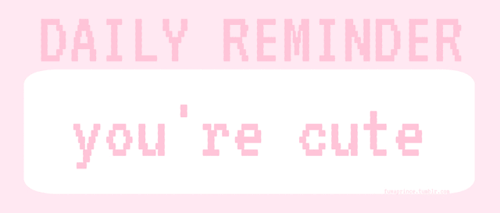
#150 things to do when you're bored#jnquette#self care#self healing#self love#self worth#loablr#wonyoungism#pink pilates princess#studyblr
1K notes
·
View notes
Note
Hello!! Sorry for bothering you, I've been wanting to ask about the development of your game for a long time :"D
Will this game be available in a mobile version? (Because unfortunately I don't have anything with me except my phone, but I would like to try it in the future. I like your work process and I look forward to your result! 😭💕)

YOU'RE NOT BOTHERING ME OMG😭💔💔💔, yes I can do a phone version ! ! ! Making the game into other platforms is one of the main ideas so anyone in the fandom can play it
I also got another question like that from:

There's some options from the renpy app itself in the laptop that I can do to change the platform that the game could be playable before making it a game itself
Basic menu of renpy
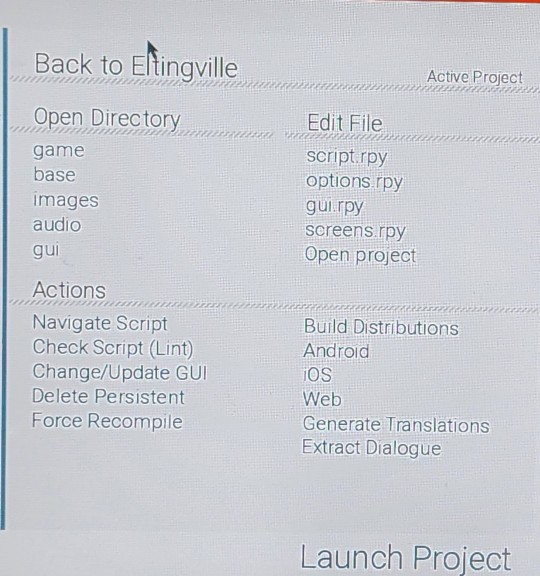
Build distributions (no idea of this yet)
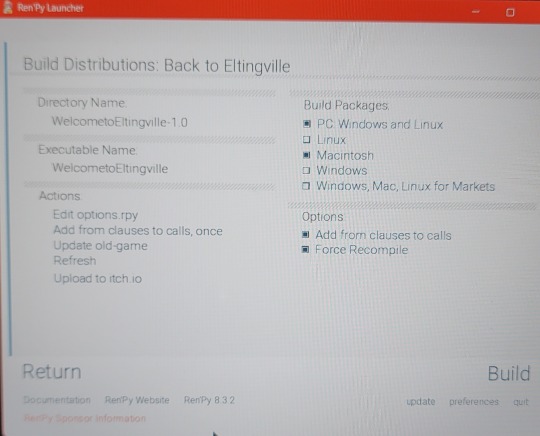
And YESSS the Android option is there to make it into a playable game in the phone but I heard is more of a wonky process since it needs to get all the buttons re-do + the screen touch can be wonky sometimes (that's what I heard😭😭😭) and there's also IOS idk
I don't wanna touch it yet so I'm mostly guiding myself with tutorials in any case, most of my learning in renpy comes from my IT tech classes and tutorials
#back to eltingville#bte: game process#renpy#eltingville#renpy game#the eltingville club#renpy visual novel#evan dorkin
25 notes
·
View notes
Note
How does Klein see the other Klein bots? Does he see them as brothers or just as copies of him also are the Klein bots build in a lab or storage?
://SYSTEM_MESSAGE_ANSWERED
klein simply sees them as copies, it's like "oh another me!", but that's all there is to it. they're also programmed to not talk to other kleins as to not confuse people. most of klein's interactions are made to be focused on his darling only
both klein app and klein androids are founded and manufactured by a company called SentientTechLabs ! it's not really mentioned in the demo yet, but you'll learn more about it as the story progresses ^^
80 notes
·
View notes
Text
wanna up computer literacy in the newer gens?
make them install and use linux with a partitioned dual boot.
have them make an app to put on their own android phone.
get them into gmod.
have them home brew a 3ds.
show them a 2077 cyberdeck.
show them rugged build computers and custom fabricated cases for portable micro atx builds.
teach them emulation and safe practice torrenting.
teach them to steal.
teach them to love janky tech and cables running across floors and walls and ceilings.
have them learn the components of a motherboard and how to build their own computer.
teach them to install custom firmware in their car's display.
teach them to proxy and how to access sites that aren't suggested by Google.
you know what taught me computer literacy?
i wanted something i couldn't have and made do.
these kids need to learn to be curious.
if you don't look at something and ask yourself "how does that work?" and then learn about it what the fuck are you even alive for?
#I keep seeing posts about reduced computer literacy because of closed systems and it breaks my heart#computer literacy is punk as fuck
156 notes
·
View notes
Text
Not gonna lie. I wrote my first programs 34 years ago but I never was a "real" developer in the sense that I'd write fast desktop apps, manage threads, and all that low level stuff. So learning Rust in the past few months, even if I have some very basic experience with programming in assembly, is still a lot to digest. However, today I got back to my test project and am really hyped that I have.... a button that increments a number.
"Ha, I can do that in javascript in 10 minutes." I mean yeah. Obviously. Anyone can. Here's the cool thing tho. I made mine overly complicated.
The UI looks as you'd expect it to, mostly a starter project leftovers:

The HTML is as simple as can be, just plain HTML and javascript, no compile step. We live in stone ages here and we love it.

The submit button has a simple handler in javascript:
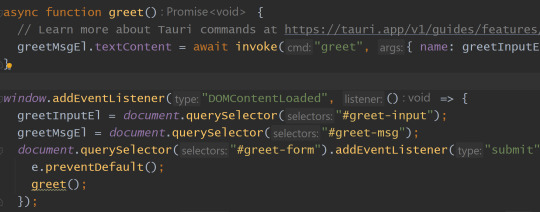
This is, once again, trivial, and all just from the template project. Bottom part says "when a user clicks this button, call "greet" function". The top part is the greet function that invokes a Tauri command also called "greet".
What's Tauri? An open source project that lets you write JS/TS/Rust applications with WebView and bundle them as stand-alone, self-contained, one-file applications for desktop, and starting with Tauri 2.0 (now in beta.2) also for Android (and later iOS). If you know Electron (Slack, Spotify, Discord etc all use Electron, they're just websites with Chromium and C++ code packaged around them).
Anyway. Tauri runs a Rust "server" application that serves your HTML/JS app, but also lets you run high-performance Rust code. Adding a command is relatively simple:
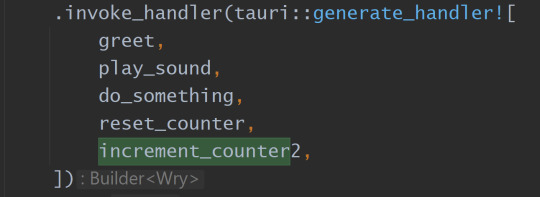
Here's where things get interesting. For me.
Because I wanted to learn Bevy, a game engine written in Rust, because I want to learn how to write using a high-performance functional-programming-like pattern called ECS (Entity Component System), I have added Bevy to this project.
However, both Tauri and Bevy block on the main thread, so I had to find a tutorial on how to spawn Bevy in a different thread, and how to pass information to it. An example:
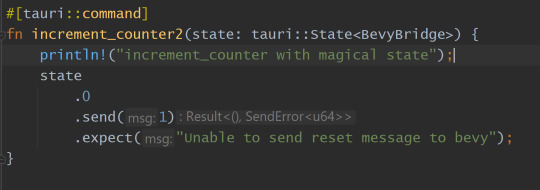
#[tauri::command] turns a normal function into a Tauri command that I can call from HTML/JS. It injects resource called BevyBridge which is just two lines of code: #[derive(Resource)] pub struct BevyBridge(pub Sender<u64>, pub Receiver<;u64>);
Sender and Receiver being from crossbeam-channel bevy crate which is for sending data back and forth safely and quickly between individual threads.
so "state.0.send(1)" means I'm sending a 64-bit unsigned integer with a value 1 to the channel.
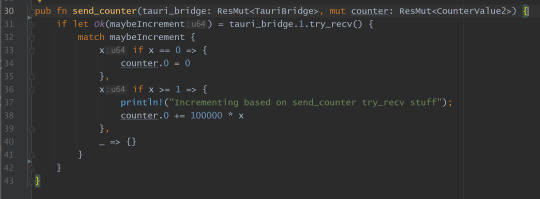
And this is how to receive the message - inside of Bevy engine, in a separate thread. For simplicity, if I send zero, it resets the counter, and if I send any number it adds 100000 to the number, just for clarity. (Elsewhere I'm incrementing it by 1 on every game loop, so theoretically 60x a second. Or 15000x a second because Bevy is unreasonably fast and it doesn't need to render anything in this setup.)
And the best part is that with a single command (cargo tauri build) I get an .msi file, an .exe installer, both around 4MB, and a 11MB .exe file with no dependencies besides WebView (installed on every current desktop OS by default). There's just something about giving someone a floppy disk with an executable that you made yourself.
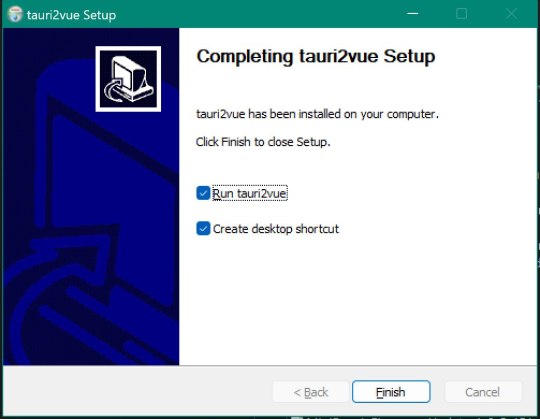
Is it dumb? Yes. Does it make me happy? No. Does it make me glad, and very relieved that I'm not completely lost? You bet.
28 notes
·
View notes
Text
BDS has partnered with the Boycat App

The BDS movement has officially partnered with Boycat, an innovative ethical shopping platform and application, in order to allow you to join consumer-focused BDS campaigns more effectively. Since the beginning of Israel’s genocide against 2.3 million Palestinians in the occupied Gaza Strip, calls to boycott companies complicit in Israel’s crimes have never been more popular. Now, the Boycat app makes it easier than ever to correctly identify BDS priority targets. Through the app users can check these regularly updated BDS targets, scan products, learn about companies, build your ethical shopping profile, join local teams and directly support our priority campaigns, ensuring your purchasing decisions contribute to a larger movement for justice. A key element of our partnership with Boycat is the app’s tiering system, categorizing corporations based on the level of their involvement in Israel’s crimes and the priorities of the BDS movement. This allows you to focus on strategic campaigns of the BDS movement while also learning more and taking action against other complicit corporations implicated in Israel’s genocide, apartheid and illegal occupation. Now you can stay informed about BDS priority campaigns and strategies in real-time. For instance, if we call for a boycott of a company due to its complicity with Israeli crimes, Boycat will immediately inform you, offering the latest information, calls to action, and educational resources to ensure you are informed and ready to act. As the Palestinian liberation cause gathers unprecedented momentum, millions of people of conscience around the world are eager to learn more about, and support, the Palestinian-led BDS movement. Download Boycat on IOS, Android, and Web Extension and escalate all BDS campaigns to hold corporations accountable for their complicity in Israel’s grave violations of international law, and support our struggle for freedom, justice and equality. Together, let’s end Israel’s genocide in Gaza and dismantle its decades-old regime of settler-colonial apartheid. Get the app!
10 notes
·
View notes
Text
How to Build Software Projects for Beginners

Building software projects is one of the best ways to learn programming and gain practical experience. Whether you want to enhance your resume or simply enjoy coding, starting your own project can be incredibly rewarding. Here’s a step-by-step guide to help you get started.
1. Choose Your Project Idea
Select a project that interests you and is appropriate for your skill level. Here are some ideas:
To-do list application
Personal blog or portfolio website
Weather app using a public API
Simple game (like Tic-Tac-Toe)
2. Define the Scope
Outline what features you want in your project. Start small and focus on the minimum viable product (MVP) — the simplest version of your idea that is still functional. You can always add more features later!
3. Choose the Right Tools and Technologies
Based on your project, choose the appropriate programming languages, frameworks, and tools:
Web Development: HTML, CSS, JavaScript, React, or Django
Mobile Development: Flutter, React Native, or native languages (Java/Kotlin for Android, Swift for iOS)
Game Development: Unity (C#), Godot (GDScript), or Pygame (Python)
4. Set Up Your Development Environment
Install the necessary software and tools:
Code editor (e.g., Visual Studio Code, Atom, or Sublime Text)
Version control (e.g., Git and GitHub for collaboration and backup)
Frameworks and libraries (install via package managers like npm, pip, or gems)
5. Break Down the Project into Tasks
Divide your project into smaller, manageable tasks. Create a to-do list or use project management tools like Trello or Asana to keep track of your progress.
6. Start Coding!
Begin with the core functionality of your project. Don’t worry about perfection at this stage. Focus on getting your code to work, and remember to:
Write clean, readable code
Test your code frequently
Commit your changes regularly using Git
7. Test and Debug
Once you have a working version, thoroughly test it. Look for bugs and fix any issues you encounter. Testing ensures your software functions correctly and provides a better user experience.
8. Seek Feedback
Share your project with friends, family, or online communities. Feedback can provide valuable insights and suggestions for improvement. Consider platforms like GitHub to showcase your work and get input from other developers.
9. Iterate and Improve
Based on feedback, make improvements and add new features. Software development is an iterative process, so don’t hesitate to refine your project continuously.
10. Document Your Work
Write documentation for your project. Include instructions on how to set it up, use it, and contribute. Good documentation helps others understand your project and can attract potential collaborators.
Conclusion
Building software projects is a fantastic way to learn and grow as a developer. Follow these steps, stay persistent, and enjoy the process. Remember, every project is a learning experience that will enhance your skills and confidence!
3 notes
·
View notes
Text
Explore the Future of Mobile Apps: Android Development Course by Code with TLS
As the world becomes more interconnected through mobile technology, the demand for Android app development continues to rise. With over 2.8 billion active Android devices worldwide, mastering Android app development is a gateway to a thriving career in tech. If you're looking to dive into the world of mobile apps, Code with TLS offers a comprehensive Android App Development course designed to equip you with the skills and knowledge needed to succeed in this dynamic field.
Why Learn Android App Development?
Mobile applications have revolutionized the way we live, work, and communicate. From banking apps to social media platforms and productivity tools, the Android ecosystem offers endless opportunities for innovation. By learning Android app development, you can build apps that solve real-world problems, enhance user experiences, and even launch your own startup. Whether you’re a student, a working professional, or a tech enthusiast, mastering Android development will open doors to endless possibilities in the tech world.
What Makes Code with TLS Your Ideal Tech Course Provider?
Code with TLS is a leading tech course provider, known for its hands-on, practical approach to learning. The Android app development course is tailored for both beginners and those with some coding experience. The curriculum covers everything from the fundamentals of Android development to advanced topics such as UI/UX design, database integration, and using APIs to make your apps dynamic.
By enrolling in Code with TLS, you’ll benefit from:
Expert-Led Instruction: Learn from industry professionals who bring real-world experience and practical insights.
Project-Based Learning: Gain hands-on experience by working on real Android app projects, preparing you for actual job opportunities.
24/7 Support: Get assistance whenever you need it from mentors who are always ready to help you succeed.
Certifications: Upon completion, you’ll receive a certification that showcases your skills and enhances your credibility in the job market.
The Future of Android App Development
The future of Android app development looks incredibly promising. With advancements in AI, IoT, and 5G technology, the demand for sophisticated and high-performance apps is only going to grow. Learning Android app development today positions you to be at the forefront of this rapidly evolving industry. Whether you’re interested in creating apps for smart devices, augmented reality, or integrating machine learning, the opportunities are boundless.
Code with TLS ensures that you're not just learning to code but are preparing for the future of Android app development. So why wait? Enroll today and start your journey into the exciting world of mobile app development.
#Android App Development#Learn Android Development#Code with TLS#Mobile App Development Course#Tech Course Provider#Best Android App Development Course#Android Development for Beginners#Android Development Bootcamp#Learn Coding for Android Apps#Android Programming Course#Android Developer Certification#Build Android Apps#Future of Android Development#Mobile App Development 2025#Career in Android Development
0 notes
Text
Pebble the wearable back from a long death
I started working on Pebble in 2008 to create the product of my dreams. Smartwatches didn’t exist, so I set out to build one. I’m extraordinarily happy I was able to help bring Pebble to life, alongside the core team and community. The company behind it failed but millions of Pebbles in the world kept going, many of them still to this day.
I wear my Pebble every day. It's been great (and I'm astounded it’s lasted 10 years!), but the time has come for new hardware.
You’d imagine that smartwatches have evolved considerably since 2012. I've tried every single smart watch out there, but none do it for me. No one makes a smartwatch with the core set of features I want:
Always-on e-paper screen (it’s reflective rather than emissive. Sunlight readable. Glanceable. Not distracting to others like a bright wrist)
Long battery life (one less thing to charge. It’s annoying to need extra cables when traveling)
Simple and beautiful user experience around a core set of features I use regularly (telling time, notifications, music control, alarms, weather, calendar, sleep/step tracking)
Buttons! (to play/pause/skip music on my phone without looking at the screen)
Hackable (apparently you can’t even write your own watchfaces for Apple Watch? That is wild. There were >16k watchfaces on the Pebble appstore!)
Over the years, we’ve thought about making a new smartwatch. Manufacturing hardware for a product like Pebble is infinitely easier now than 10 years ago. There are plenty of capable factories and Bluetooth chips are cheaper, more powerful and energy efficient.
The challenge has always been, at its heart, software. It’s the beautifully designed, fun, quirky operating system (OS) that makes Pebble a Pebble.
Today’s big news - Google has open sourced PebbleOS!
PebbleOS took dozens of engineers working over 4 years to build, alongside our fantastic product and QA teams. Reproducing that for new hardware would take a long time.
Instead, we took a more direct route - I asked friends at Google (which bought Fitbit, which had bought Pebble’s IP) if they could open source PebbleOS. They said yes! Over the last year, a team inside Google (including some amazing ex-Pebblers turned Googlers) has been working on this. And today is the day - the source code for PebbleOS is now available at github.com/google/pebble (see their blog post).
Thank you, Google and Rebble! I can't stress how thankful I am to Rebble and Google, in general and to a few Googlers specifically, for putting in tremendous effort over the last year to make this happen. You've helped keep the dream alive by making it possible for anyone to use, fork and improve PebbleOS. The Rebble team has also done a ton of work over the years to continue supporting Pebble software, appstore and community. Thank you!
In addition to PebbleOS, we’ve been supporting development of Cobble, an open source Pebble-compatible app for iOS (soon) and Android (works great today, it’s my daily driver).
We’re bringing Pebble back!
I had really, really, really hoped that someone else would come along and build a Pebble replacement. But no one has. So… a small team and I are diving back into the world of hardware to bring Pebble back!
This time round, we’re keeping things simple. Lessons were learned last time! I’m building a small, narrowly focused company to make these watches. I don’t envision raising money from investors, or hiring a big team. The emphasis is on sustainability. I want to keep making cool gadgets and keep Pebble going long into the future.
The new watch we’re building basically has the same specs and features as Pebble, though with some fun new stuff as well 😉 It runs open source PebbleOS, and it’s compatible with all Pebble apps and watchfaces. If you had a Pebble and loved it…this is the smartwatch for you.
More info to come soon! Follow the fun with @ericmigi and @pebble.
Are you like me?
Do you have a hole in your heart (and on your wrist) that hasn't been filled by any other smartwatch?
Sign up to be the first to get one at rePebble.com.
Eric Migicovsky
Pebble Founder
FAQ
When can I buy one?
As soon as we nail down the product specifications and get a firm idea of the production timeline, we'll share it with everyone on the list and invite people to order.
Will it be exactly like Pebble?
Yes. In almost every way.
Aren’t you the guy who screwed this up last time?
Yes, the one and only. I think I’ve learned some valuable lessons.
4 notes
·
View notes
Text
Admissions Open at MDIDM Infoway! 🎓 Looking for the right skills to land your dream job? Learn from industry experts & gain real-world experience in: ✅ Full Stack Web Development – Master front-end & back-end ✅ Graphic Design & UI/UX – Become a creative pro ✅ Android & Flutter Development – Build mobile apps ✅ Advanced Python & SEO – Stay ahead in tech ✅ AI Tools like Chat GTP & Gemini – Boost productivity 💼 Why Choose Us? 🔹 Industrial Internship & Hands-on Projects 🔹 1:1 Doubt Solving & Individual Learning 🔹 100% Placement Assistance 🚀 Future-Proof Your Career with Industry-Relevant Skills! 📍 Rajkot 📞 Call Now: +91 94265 26980 | +91 83471 93531 #MDIDMInfoway #ITCourses #WebDevelopment #GraphicDesign #AI #Python #SEO #AndroidDevelopment #Flutter #CareerGrowth #TechSkills #PHPDevelopment #BackendDevelopment #FrontendDeveloment #MobielAppDevelopment #AndroidDevelopment #FlutterDevelopment #Coressplatformdevelopment #RajkotITCompany #ITcompanyIndia #TechCompany #SoftwereDevelopment #ITServices #RajkotDevelopers

3 notes
·
View notes
Text
Celestia: Chain of Fate launches September 12 - Gematsu
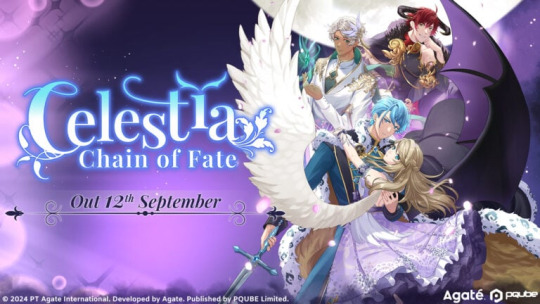
Otome visual novel Celestia: Chain of Fate will launch for Switch and PC via Steam on September 12, publisher PQube and developer Agate announced.
Celestia: Chain of Fate was originally released via Memories: My Story, My Choice, an otome visual novel stories app available for iOS via App Store and Android via Google Play.
Here is an overview of the game, via PQube:
About
Celestia: Chain of Fate is a romance-fantasy visual novel that delivers a captivating player driven narrative. The perfect life you’ve known as a daughter of a Duke is about to change forever. With the revelation of your new hybrid identity, as a descendant of Angelus and Daemon, you must learn to live in a new world. Compelled to accept an invitation to the Academy of Celestia to explore the world of magic, you must set out on a fresh journey in a world filled with demons and angels. Uncover the secrets of your family history and learn to control the magical abilities you hold. Along the way, you’ll have the chance to develop relationships with one of three romanceable characters, each with their own unique traits and personalities. It’s down to you to hold your friendships and advance your love interests while also prioritizing your education. Remember not to neglect your studies as you’ll need to overcome a series of challenges to graduate!
Key Features
Otome Visual Novel – Follow a captivating romantic fantasy about Angelus, Daemons, and Half Bloods over 20-plus hours chapters!
Romanceable Leads – Discover the diverse personalities of your love interests across three main routes – ranging from the fiery passion in Val, to the gentle warmth of Luke, to the cold reserve of Ash. Build up affection and pick the man of your dreams!
Choices and Scenarios – Control the story by choosing options that best suit you! However, tread carefully, as there are various undesirable outcomes awaiting you.
Breathtaking Illustrations – Immerse yourself in a story full of exquisite hand-crafted illustrations, brimming with intricate details. Progress will automatically unlock stunning special illustrations that enhance your experience.
Extra Stories! – No detail will be missed with the opportunity to discover more about your favorite characters! Each character will feature their own side story, providing you with the chance to delve deeper into their backgrounds and personalities!
Atmospheric Music – Enjoy the story accompanied by music, enhancing key moments, and enriching the overall experience with deeper immersion and heightened emotional depth.
Watch a new trailer below. View a set of screenshots at the gallery.
Release Date Trailer
youtube
8 notes
·
View notes
Text
When I finished the small charater info and timeline for my LR headcanon doc
but I have to draw something new to go with it that may or may not be 8 head portraits... have some sneak peeks lol
you can guess who its about (level easy):
He has no chip and his ability is the replication of all tech not just bionic. Like if he touches a megaphone he can amplify his voice or record things and amplify them. can save up to two bionics in a folder to use without touching someone. If he wants to use a different two he has to clear his folder.
Hes not super interested in relationships not in an aro way but just like not that interested. If he sees a bad bitch though whos to say lol
He and Gordo though had a massive falling out ( Break up). Never again.
He also downloads apps to do most advanced tasks or hobbies, except guitar and martial arts which he learned on his own. ( Hes loves Radiohead thats how he and Douglas began to bond heheh )
Bi queen. Also an elite-level fumbler. Not because she's a bad partner. Just so bad with expressing feelings so it never gets to that level.
“ I can call my sibling a dusty bum bitch, but if you even look at them wrong Im beating your ass.”
When he wanted to ask her out he told the truth and she was like: “Huh? You thought I believed you?? Well, you’re so cute and silly and I like you so I will go out with you!” He kept the coffee shop as a business also having made a bunch of cool gadgets to help the employees.
Perry thought he was a butch lesbian when they met but then they became friends and she was like ohhh. Bro doesn't care if he likes you he likes you, I think Perry is the same but she has some preferences. ( What if I shipped him with Agent Graham. What then? You cant stop me lol)
BI- curious for a while ( He had a fling with Peirce Harrington way back when they were in a fraternity together at some fancy Uni. You know Frat boys, I do. Freaks.)He was a Hippie, a “playboy”, a big goofy nerd, hes gone through many phases.
Ill get the full thing out when i finish these lil shit drawings
Also here's a time line lol
TimeLine
1992- Creation of Davenport Industries ( Don was 21 Doug was 17) 1994- Begins 2nd year of college for Doug ( 20) and the beginning of Marcus and Danielle ( Daniel) and the prototypes of the L-P, I-S, and S-S chips/ first meeting of Geisel 1995- Geisel begins work on the first Troy. T.R.O-1 1996- Doug Graduates and Davenport Industries begins taking off, making both Davenport's millionaires and affluential inventors and scientist 1996- Geisele and Doug break up 1996- T.R.O-2 1996- Adams embryo is now a baby boy 1997- Brees Embryo is now a baby girl 1997-T.R.O-3 1997- Marcus is sentient 1997- Chases Embryo is now a baby boy 1998-T.R.O-4 1999- Donald builds the Penthouse in Centium City 1999-T.R.O-5 2001- Geisel makes a breakthrough in the movie industry and ceases work on T.R.O-6 in favor of working her way up the industry 2002- Danielle ( Daniel) is sentient ( a few years later Danielle is Daniel) 2002- Doug (27) and Dan (31) fall out and Doug fake dies ( Adam 5, Bree 4, Chase 4) 2002- Dan finds ABC and Raises them 2006- The Gov tries to tack ABC for “science” but fails because I said so 2008-2013- Doug works with shady people to get money and he is fairly rich, he also meets Krane during this time who promises him a big payout for the tech of human bionics and partial bionics he left behind in his young adult rage 2011- Geseil completes T.R.O-7 and becomes an Industry Titan with her breakout hidden star Troy West ( if this were a big thing you’d hear about the movies hes is as sly ref across all the seasons) 2012- Dan ( 41) and Tasha ( 41) tie the knot and Leo finds out about the Rats 2013- Doug Returns and does his evil stuff but he and the android bros get redeemed 2014- Krane does all his evil stuff and teams up with Geis but also does a solo thing so he dies 2015- The Island is up and running for about a year 2016- Geis finally comes in and gets her ass handed to her 2017—- Elite force stuff
#lab rats#lab rats elite force#chase davenport#adam davenport#bree davenport#leo dooley#donald davenport#douglas davenport#tasha davenport#daniel davenport#marcus davenport
5 notes
·
View notes
Text
Top 5 Programming Languages to Master in 2025
Programming language theory is the subfield of computer science that studies the design, implementation, analysis, characterization, and classification of programming languages.
1. Java
You might ask, “Is Java obsolete?” Of course not.
Why is Java still popular? Java is one of the oldest and most robust programming languages. It is also an object-oriented language mainly used for Android application development. This is one of the main reasons it is still used today. However, with the advent of programming languages like Kotlin (also suitable for Android development), Java is becoming less popular.
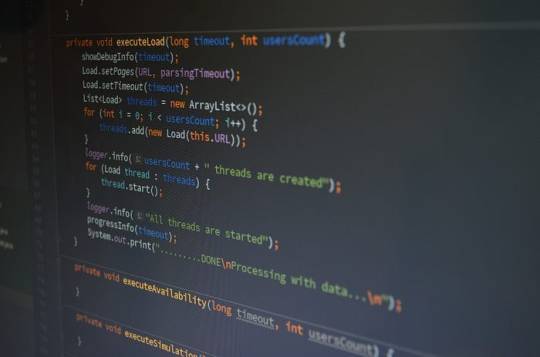
2. Swift

3. SQL
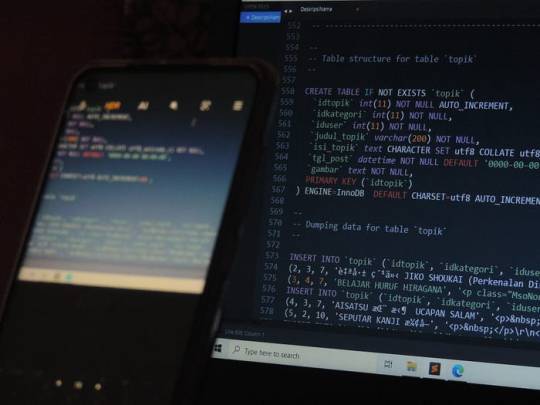
4. JavaScript
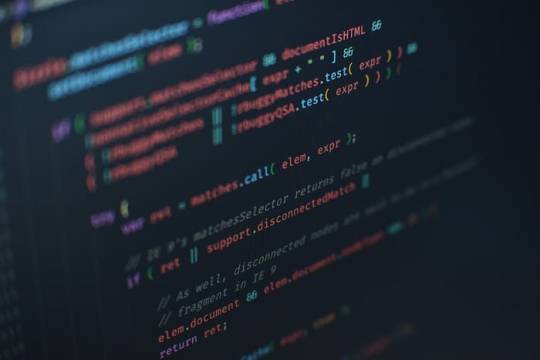
5. Python

The amazing thing about Python is that it’s a general-purpose programming language used to build a wide range of applications. Furthermore, it is active in artificial intelligence. Self-driving cars, Wal-Mart auto-payment, and many automation and machine learning (ML) apps were developed through Python. This makes this language more important and rapidly popularizes. In addition, Python is easier to learn than all other languages and is easy for beginners. You can also build complex applications relatively easily and quickly. In the United States, the average salary for Python developers is about $ 78,000, while experienced developers can be as high as $ 122,000.
2 notes
·
View notes